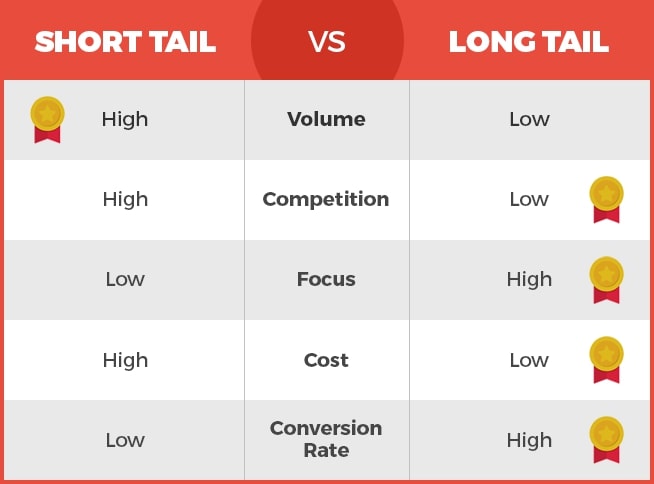Keywords are necessary if you want people to find your website. When people are looking up words related to what your business is about, you want search engines to display your website on their search pages. This is accomplished by using keywords on your website and including them in the content, and there are two kinds of them: long and short keywords.
Today, we will talk about short keywords and if you’re going to be able to rank for them in 2020, so let’s begin.

What are short keywords?
Unlike long-tail keywords, which consist of multiple words and are recommended you use for your business, short keywords consist of a smaller number of words, often one. They’re what every business aspires to use because their website will get displayed in the search results whenever people search for the short keyword.
Why are long-tail keywords recommended and not short ones?
It’s pretty simple: it’s way harder to rank for the short ones, especially one-word keywords. Imagine if you owned a pizzeria and you tried to rank for the word ‘pizza’. It would be hard with all the famous pizza chains, and your website would probably never even see the first page of Google (you would probably be lucky to be on the third one).
Compared to long-tail keywords, the competition for short keywords is far bigger and the one disadvantage they have is that they’re often vague.
If you own grooming business and try to rank for the word ‘dog’, you might get clicks from people who want to learn about dogs and want to adopt them, which is not good if you’re using Google Search Ads because you’re losing money from their clicks.

A great example of a good short keyword ranking
It may sound impossible to rank for short keywords, but it can be done. In a project Moz did for Pipedrive, a customer relationship manager, they managed to rank them on top of the first page of Google using a competitive keyword.
They took eight steps to reach that goal: they first selected the right topic, then created good content for their own blog, then they optimized on-page SEO. Afterward, they built internal links, found people who wanted to link that content, and wrote content that was posted on those websites.
The keyword they worked with was simple and short: sales management. Not vague, but definitely competitive.
How did they do it?
After thorough research, they decided to write topics that weren’t too generic. ‘What is sales management’ is something people are looking for, but everyone is writing those articles, so they decided to write something different, an article called ‘Sales management definition, process, strategies, and resources’.
This way, they ranked for keywords such as ‘sales management definition’, ‘sales management process’, ‘sales management strategies’, and ‘sales management resources’. These word additions, also known as modifiers, increase traffic significantly.
Quality featured content
They used the right keywords in the headlines and made sure that the content wasn’t stuffed with keywords and was actually informative and made people want to read the whole thing.
After this, the Moz team found the top ten results for backlinks and reached out to people who wanted to post this content on their websites. They reached out to them kindly and got them to feature the content they wrote, while Moz featured their content in return.
At the end of the process, they improved the Pipeline’s rank from #4 to #2 for the short keyword ‘sales management’ and thirteen days later, from #2 to #1. They’re still doing strong and if you google ‘sales management’, Pipedrive will be the #1 result.
How long did it take?
We’ve mentioned that ranking for short keywords is very difficult, so it comes as no surprise that it took them 3 months and 3 team members to do it. The writing took weeks because they wanted to make sure the content was perfectly optimized and the right number of keywords and related keywords was met.
They didn’t want to just write content overstuffed with keywords; they wanted quality SEO driven content that people would read and share, thus increasing the traffic more.

Even summarized, the process sounds exhausting and long, but we cannot say that it didn’t pay off in the end. Not only did they get Pipedrive on the first page, but they also made them the first result. That’s a successful campaign if I’ve ever seen one.
Why should you focus on long-tail keywords?
Aside from the fact that it’s much easier to rank with long-tail keywords and that the competition is significantly smaller, there are other reasons, as well.
Voice search is becoming more and more popular by the day. Statistics show that global smart speaker sales will pass $30 million by 2024, and they predict that half of all online searches will be voice searches by 2020.
But what does this have to do with long-tail keywords?
It’s simple: when people are using voice search, they’re speaking to their device as if it were a person. Since they don’t have to type, they’re asking long questions, which include long-tail keywords. Instead of googling just pizza, they’re asking: ‘What are the closest pizza places near me?’.
Also, long-tail keywords have better conversion rates (the average conversion for long-tail keywords is 36%) and account for 70% of all searches.

Conclusion
Ranking for short keywords is possible, although it’s pretty difficult. It takes months and a lot of hard work and while it definitely pays off in the end, if you don’t have the budget or the time, ranking for long-tail keywords is much easier.
Hopefully, we helped you learn something new today and thank you for reading!





